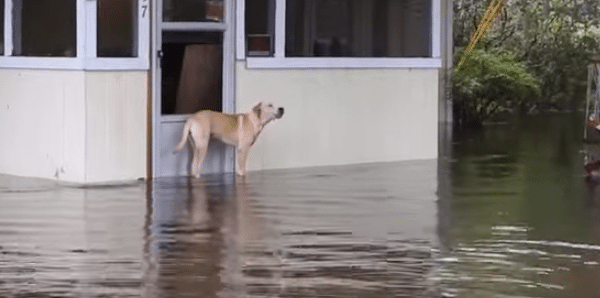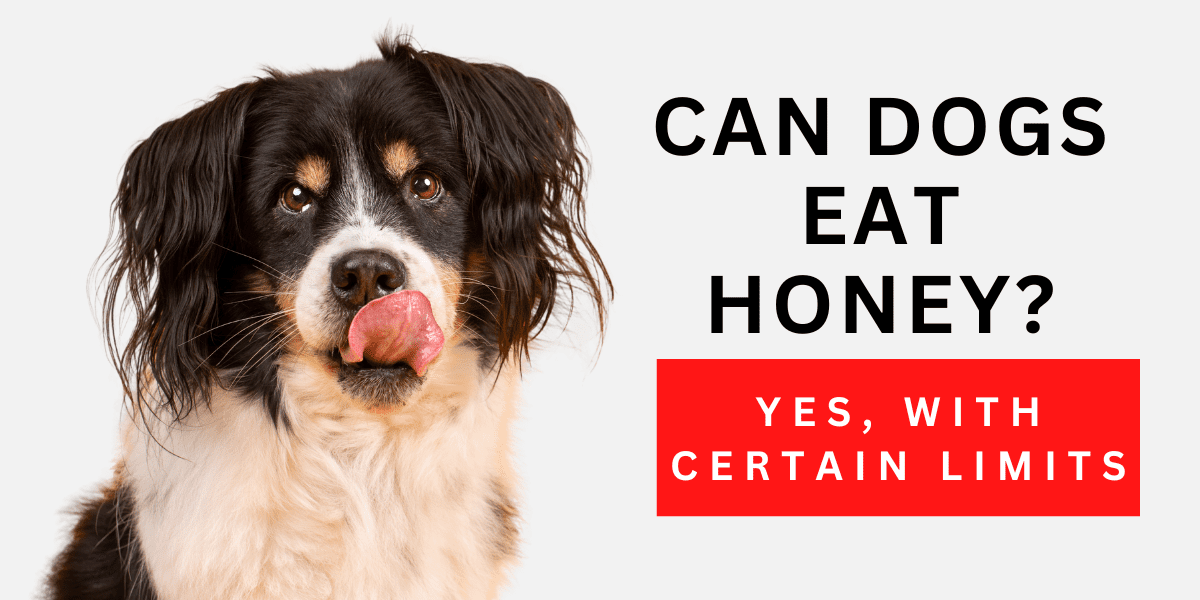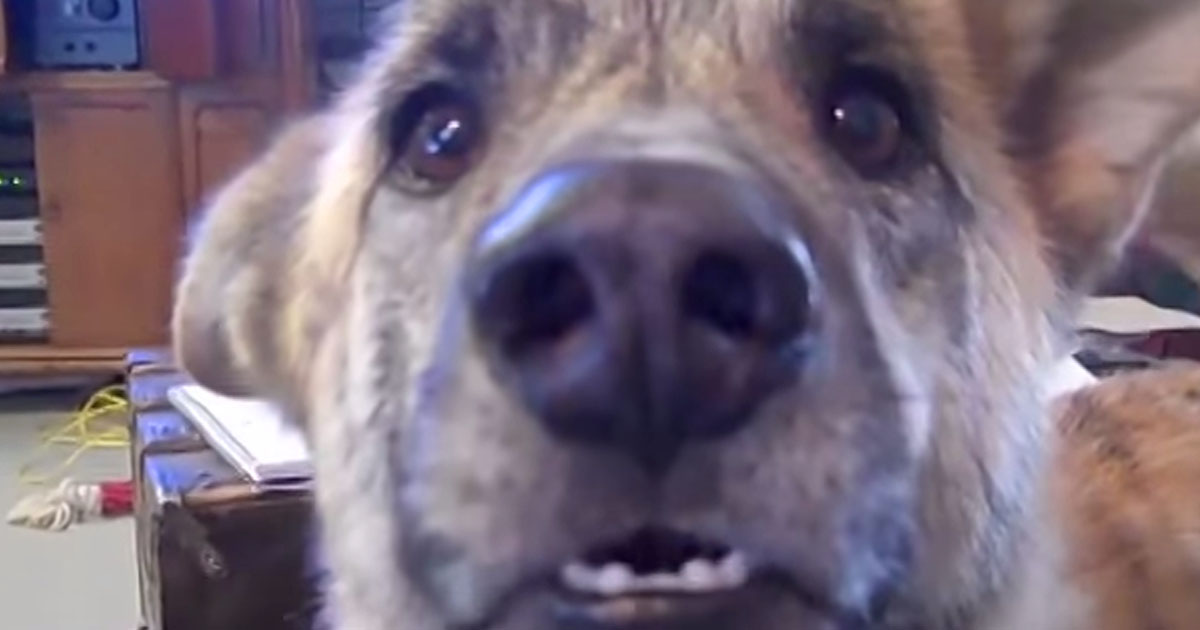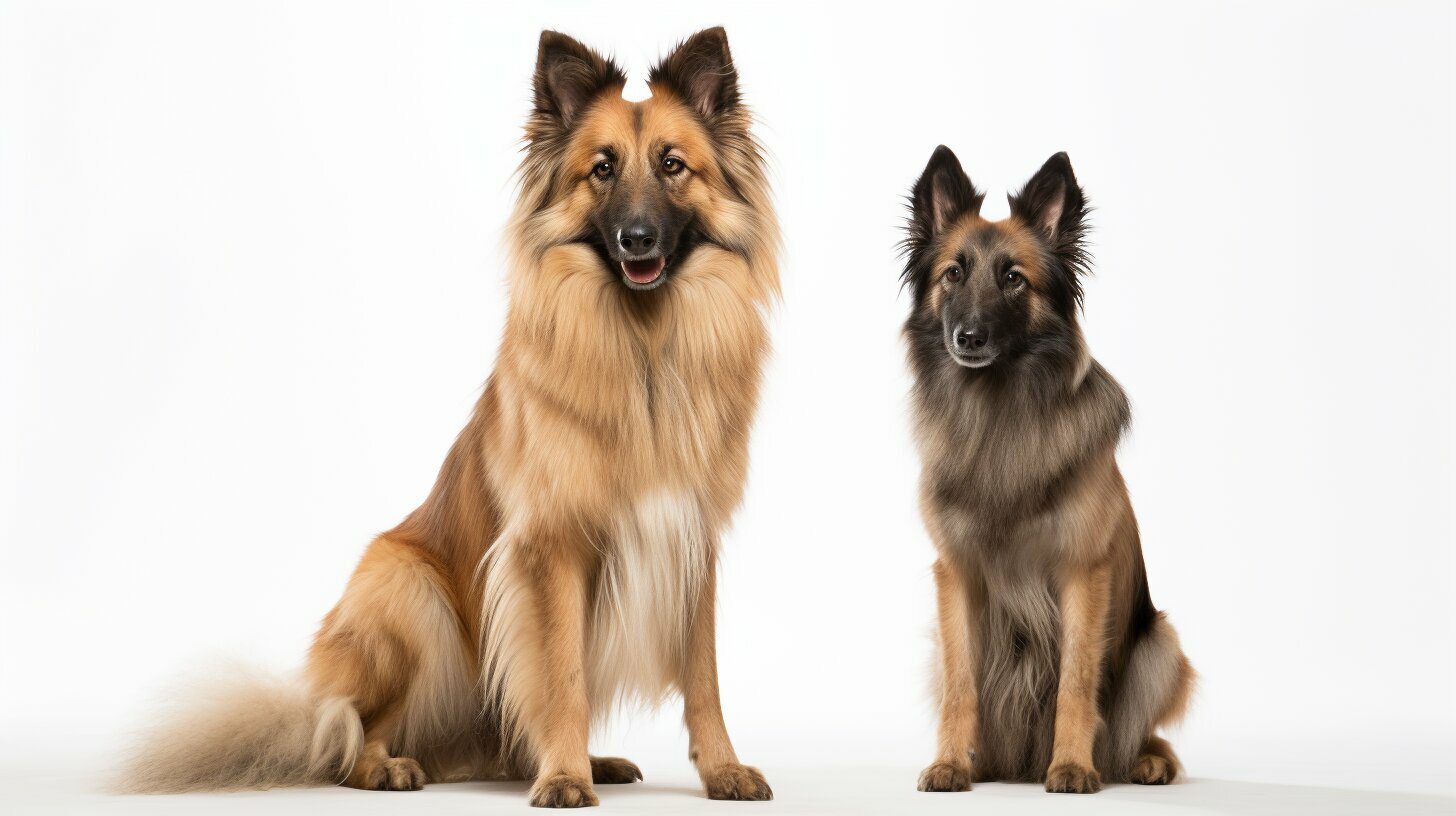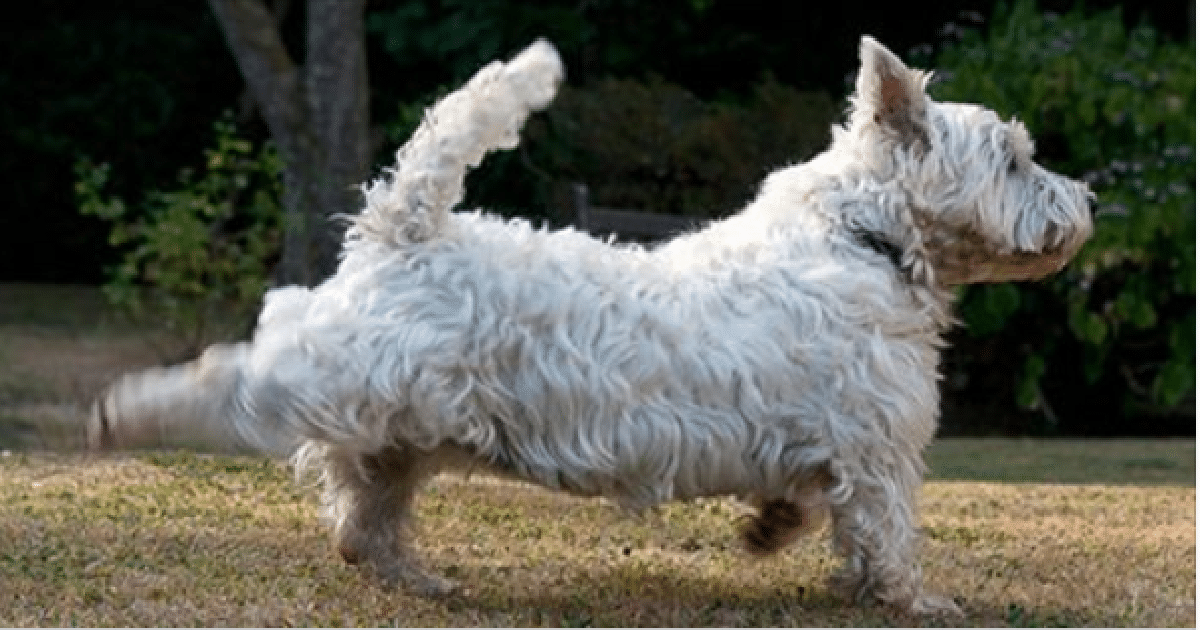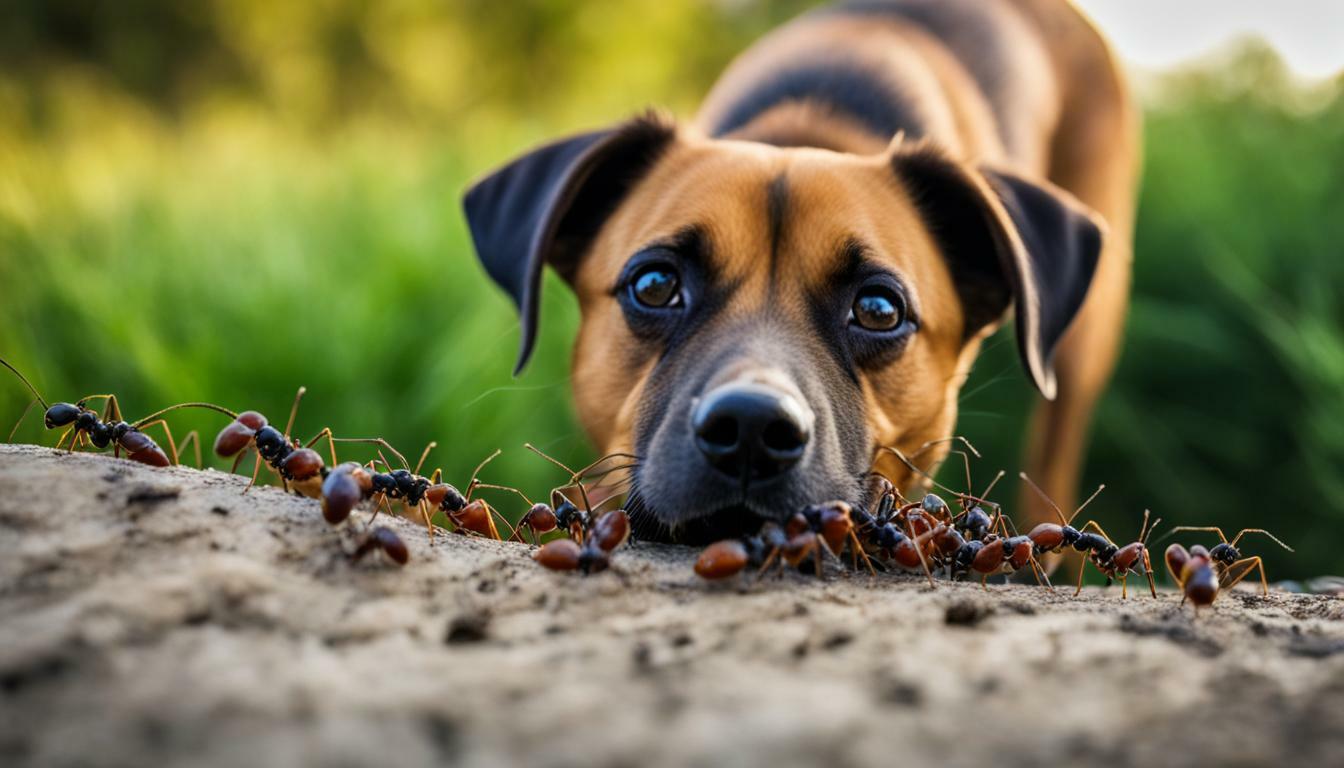
Many dog owners have wondered, “Can dogs eat ants?” Let’s find out if ants are a safe snack for our furry friends.
Factual data: Dogs can eat ants, but it is generally not recommended due to potential discomfort and the presence of harmful substances in certain species of ants. Ants can have an acidic taste and may bite or sting, causing problems for dogs. While an occasional ant is unlikely to harm a dog, a larger quantity can cause stomach upset or even allergic reactions.
If a dog eats a small number of ants, it is important to monitor them for any signs of discomfort or unusual behavior. If a dog eats a large number of ants or ants that are known to be harmful, immediate veterinary assistance is recommended.
It is possible to train dogs to ignore or walk away from ants using the “Leave It” command. Keeping ants out of dog food involves strategies such as regular cleaning, proper storage, and using natural deterrents. If ants are already in a dog’s food, it is important to not use insecticide near the food. Instead, non-toxic insecticides like diatomaceous earth can be used around the perimeter of the home.
Overall, while ants are generally a safe snack for dogs, it is important to be aware of potential risks and take necessary precautions.
Key Takeaways:
- Dogs can eat ants, but it is generally not recommended due to potential discomfort and the presence of harmful substances.
- Ants can have an acidic taste and may bite or sting, causing problems for dogs.
- A small number of ants is unlikely to harm a dog, but a larger quantity can cause stomach upset or allergic reactions.
- Monitor your dog for any signs of discomfort or unusual behavior if they have consumed ants.
- Seek immediate veterinary assistance if your dog has consumed a large number of ants or ants that are known to be harmful.
Potential Risks of Dogs Eating Ants
While ants may seem harmless, there are several factors to consider regarding their impact on a dog’s health. Ants can have an acidic taste and may bite or sting, causing problems for dogs. In addition, certain species of ants contain substances that can be harmful to dogs if ingested in large quantities. For example, some ants release formic acid, which can irritate a dog’s digestive system and lead to stomach upset.
Furthermore, if a dog consumes a large number of ants or ants that are known to be harmful, it can result in more severe side effects. These can range from gastrointestinal issues such as vomiting and diarrhea to allergic reactions, which may cause symptoms like swelling, itching, and difficulty breathing. It is crucial to monitor a dog’s behavior and overall health after they have eaten ants to ensure their well-being.
To minimize the risk of ants causing discomfort or harm to dogs, it is advisable to prevent them from coming into contact with ants in the first place. This can be achieved by keeping the dog’s environment clean and free from ant colonies. Additionally, training dogs to ignore or walk away from ants using the “Leave It” command can be an effective preventive measure. By teaching dogs to avoid ants, owners can help protect their pets from potential risks associated with ant consumption.
| Signs of potential discomfort or allergic reaction: |
|---|
|
|
|
|
|
The Role of Ant Species in Dog Safety
It is important to note that not all ant species pose the same level of risk to dogs. Some ants, such as fire ants, are known for their aggressive nature and potent venom, which can cause severe reactions in dogs. On the other hand, other ant species may be relatively harmless and less likely to cause significant health issues. Knowing the specific ant species present in your area can help assess the potential risks they pose to your pets.
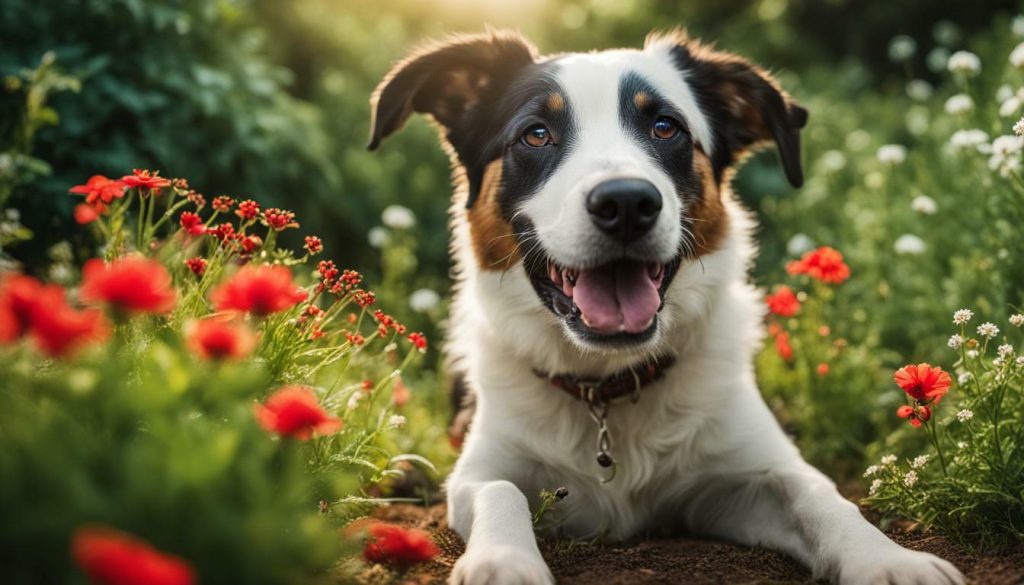
Overall, while it is generally not recommended for dogs to eat ants, occasional ingestion of a small number of ants is unlikely to cause harm. However, if a dog shows any signs of discomfort, or allergic reactions, or has consumed a large quantity of ants, it is crucial to seek immediate veterinary assistance. By being proactive in preventing ant exposure and monitoring a dog’s behavior, owners can help ensure the well-being and safety of their furry companions.
The Role of Ant Species in Dog Safety
Not all ants are created equal when it comes to their impact on a dog’s health – certain species can pose greater risks than others. While some ants are relatively harmless if ingested, others can be toxic and lead to significant health issues for our furry friends. It is crucial for dog owners to be aware of the potential dangers associated with different ant species and take appropriate measures to keep their pets safe.
One example of an ant species that can be harmful to dogs is the fire ant. These aggressive ants are known for their painful bites and stings, which can cause intense itching, swelling, and discomfort for dogs. In some cases, dogs may develop allergic reactions to fire ant venom, leading to more severe symptoms such as difficulty breathing or even anaphylactic shock. Prompt veterinary care is essential if a dog has encountered fire ants or shows signs of an allergic reaction.
Another species of concern is the carpenter ant. These ants have powerful jaws and can deliver painful bites, but their biggest threat lies in their ability to damage wooden structures. If carpenter ants infest a dog’s living environment, they can weaken furniture, flooring, and other wooden objects. Ingesting carpenter ants may also lead to gastrointestinal issues for dogs, causing stomach upset or vomiting. Prevention, early detection, and professional pest control are crucial in managing carpenter ant infestations and protecting both the dog and the home.
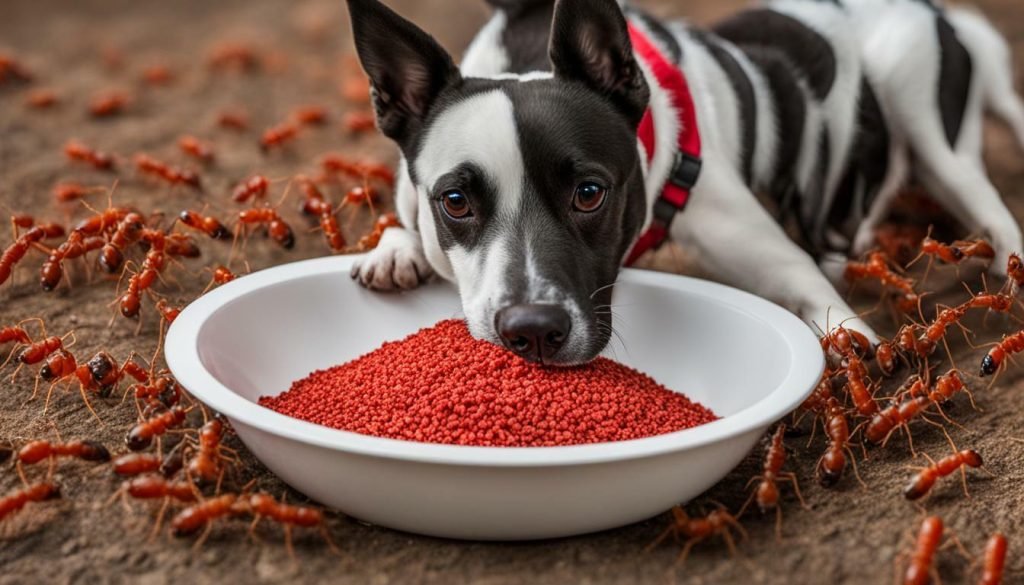
When it comes to keeping our canine companions safe, prevention is key. By identifying and understanding the specific ant species that pose risks for dogs, we can take proactive steps to minimize exposure and potential harm. It is essential to keep dogs away from ant colonies, especially those of fire ants and carpenter ants. If there are ant hills in the yard or nearby areas, creating physical barriers or using natural deterrents can help deter ants.
In conclusion, while some ants may seem harmless, certain species can pose significant risks to a dog’s health. It is important for dog owners to be familiar with the potential dangers of different ant species and take appropriate measures to prevent their pets from encountering harmful ants. Regular monitoring of dogs’ behavior and immediate veterinary attention in case of any unusual symptoms are essential for their well-being. By understanding the role of ant species in dog safety, we can ensure a healthier and safer environment for our beloved four-legged companions.
Potential Discomfort and Allergic Reactions
Dogs may experience stomach upset or even allergic reactions if they consume a large quantity of ants or ants that are known to be harmful. While an occasional ant is unlikely to cause any significant issues, it is important for pet owners to be aware of the potential risks.
Some species of ants produce and release formic acid, which can cause discomfort and irritation if ingested by dogs. The acidic taste of ants may also lead to gastrointestinal upset, resulting in symptoms such as vomiting, diarrhea, or loss of appetite. In more severe cases, dogs may exhibit signs of an allergic reaction, including swelling, itching, or difficulty breathing.
To ensure the well-being of your furry friend, it is crucial to monitor their behavior and health after consuming ants. If you notice any signs of discomfort or unusual behavior, it is recommended to consult a veterinarian for guidance. They will be able to assess the situation and provide appropriate treatment if needed.
Preventing and Treating Ant-Related Issues
There are several steps you can take to prevent ants from becoming a nuisance and keep your dog safe:
- Keep your home clean and free from ant trails by regularly wiping down surfaces and sweeping the floors.
- Store your dog’s food in airtight containers to prevent ants from accessing it.
- Use natural deterrents, such as cinnamon or vinegar, to discourage ants from entering your home.
- Seal any cracks or openings in doors, windows, or walls to prevent ants from entering your living space.
- If ants have already infiltrated your dog’s food, avoid using insecticides near the food. Instead, clean the food bowl thoroughly and use non-toxic insecticides around the perimeter of your home.
By following these preventive measures and being vigilant about your dog’s interaction with ants, you can help minimize the potential discomfort and risks associated with ant consumption.
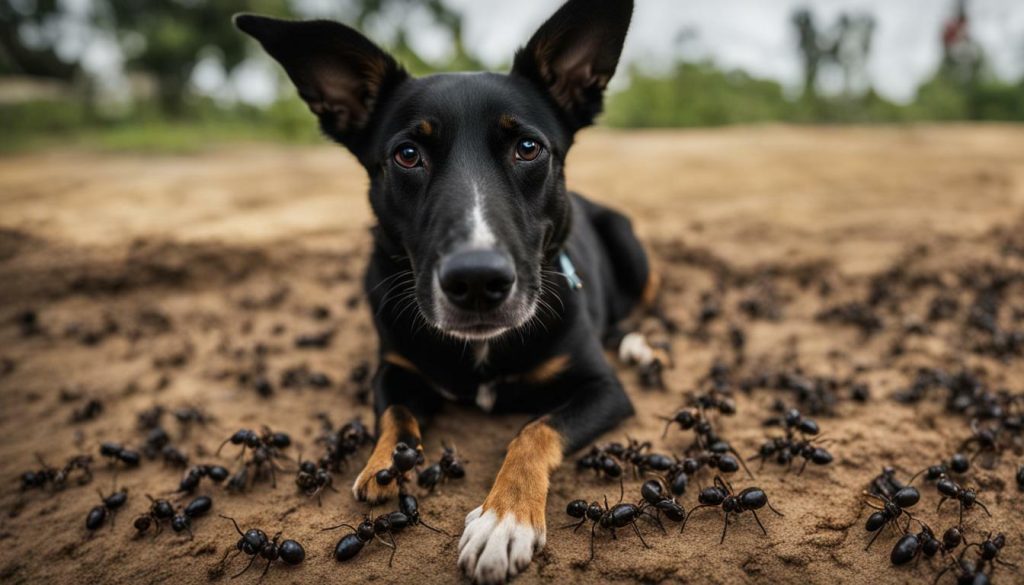
| Species of Ant | Harmful Substances |
|---|---|
| Fire ants | Formic acid, venom |
| Carpenter ants | Camponotin, mandibular gland secretions |
| Red imported fire ants | Solenopsin |
| Bull ants | Myrmecia toxin |
“It is always better to err on the side of caution when it comes to your dog’s health. Monitor their behavior closely and seek veterinary advice if you have any concerns.”
Monitoring Your Dog’s Ant Consumption
If your dog has eaten a small number of ants, it is important to closely observe them for any signs of discomfort or changes in behavior. While ants are generally considered safe for dogs in small quantities, some dogs may have allergies or sensitivities that can lead to adverse reactions. Therefore, it is crucial to stay vigilant and take necessary steps to ensure your dog’s health and well-being.
One way to monitor your dog’s ant consumption is to keep a close eye on their digestive system. If your dog shows any signs of stomach upset, such as vomiting, diarrhea, or loss of appetite, it could be a result of consuming ants. Additionally, observe their behavior for any unusual reactions, such as excessive scratching or licking, which may indicate an allergic reaction.
To better understand the impacts of ants on your dog’s health, consult with your veterinarian. They can provide valuable guidance and advice tailored to your dog’s specific needs. They may also recommend preventive measures or treatment options if necessary.
Remember, prevention is always better than cure. By keeping ants away from your dog’s food and living spaces, you can minimize the risks associated with ant consumption. Regularly clean your dog’s food and water bowls, ensuring they are free from any ant presence. Store dry pet food in airtight containers to prevent ants from getting attracted to it. Additionally, you can use natural deterrents, such as lemon or vinegar, to create a barrier and discourage ants from entering your home.
| Signs of Discomfort | Allergic Reactions | Preventive Measures |
|---|---|---|
| Stomach upset (vomiting, diarrhea) | Excessive scratching or licking | Clean food and water bowls regularly |
| Loss of appetite | Swelling of the face or body | Store pet food in airtight containers |
| Unusual behavior | Difficulty breathing | Use natural deterrents (lemon, vinegar) |
In conclusion, while ants are generally considered safe for dogs in small quantities, it is important to monitor your dog’s ant consumption and take necessary precautions. If you notice any signs of discomfort or allergic reactions, consult with your veterinarian for appropriate guidance. By implementing preventive measures and staying vigilant, you can ensure the health and well-being of your furry friend.
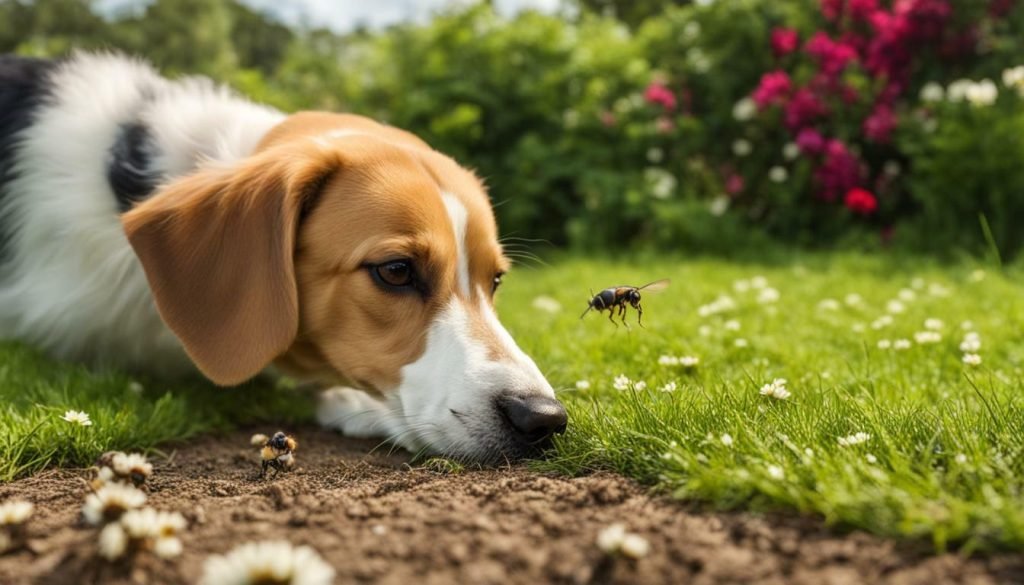
Training your dog to avoid ants can help prevent potential health issues and keep them safe outdoors. Whether you have noticed your dog’s curiosity towards ants or you live in an area where ants are prevalent, teaching your dog to steer clear of these tiny insects can be beneficial for their well-being.
One effective training technique is the “Leave It” command. Start by placing a few ants on the ground and gently guide your dog’s attention away from them using the command. Reward them with a treat or praise when they comply. Repeat this exercise regularly, gradually increasing the number of ants until your dog consistently responds to the command and avoids the ants.
It’s important to remember that consistency is key. Practice the “Leave It” command in different environments and with various distractions to reinforce your dog’s understanding. Reinforcement can also be helpful in reinforcing positive behavior. For example, if your dog naturally avoids ants, reward them with a treat or praise to encourage this behavior.
In addition to training, it’s essential to create an environment that discourages ant presence. Regularly clean up food spills, seal gaps in doorways and windows, and store dog food properly to reduce the likelihood of ants being attracted to your dog’s meal. Natural deterrents such as vinegar or citrus can also be used to create a barrier that ants are less likely to cross.
| Training Tips to Avoid Ants |
|---|
| Consistently reinforce the “Leave It” command |
| Practice in various environments and with distractions |
| Reward positive behavior with treats or praise |
| Clean up food spills promptly |
| Seal gaps in doorways and windows |
| Store dog food properly |
| Use natural deterrents like vinegar or citrus |
Conclusion
Training dogs to avoid ants is an important step towards ensuring their safety and well-being. Through consistent training and creating an ant-resistant environment, you can help prevent potential health issues that may arise from ant consumption. Remember to always monitor your dog’s behavior and consult a veterinarian if you notice any signs of discomfort or adverse reactions.
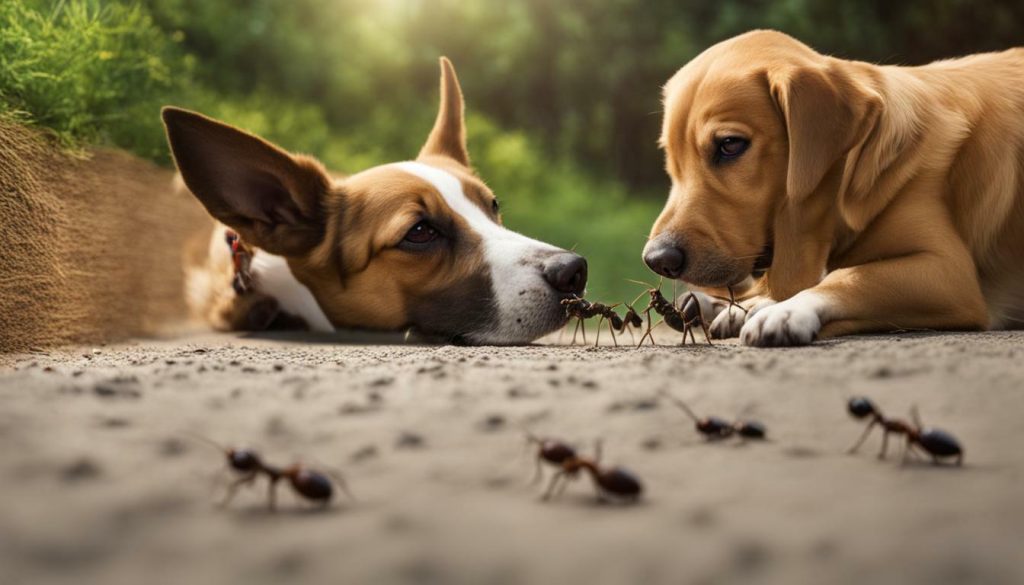
Preventing ants from accessing your dog’s food is crucial to ensuring their health and well-being. Ants can contaminate the food with bacteria, and some species of ants produce harmful substances that can be toxic to dogs. Here are some strategies to keep ants away from your dog’s food:
- Cleanliness: Regularly clean your dog’s food bowl with mild soap and water to remove any food residue that might attract ants.
- Proper Storage: Store your dog’s food in airtight containers to prevent ants from getting in. Avoid leaving open bags of food lying around.
- Natural Deterrents: Ants dislike the smell of certain herbs and spices. Sprinkle some cinnamon, peppermint, or bay leaves around the area where you keep your dog’s food to discourage ants from approaching.
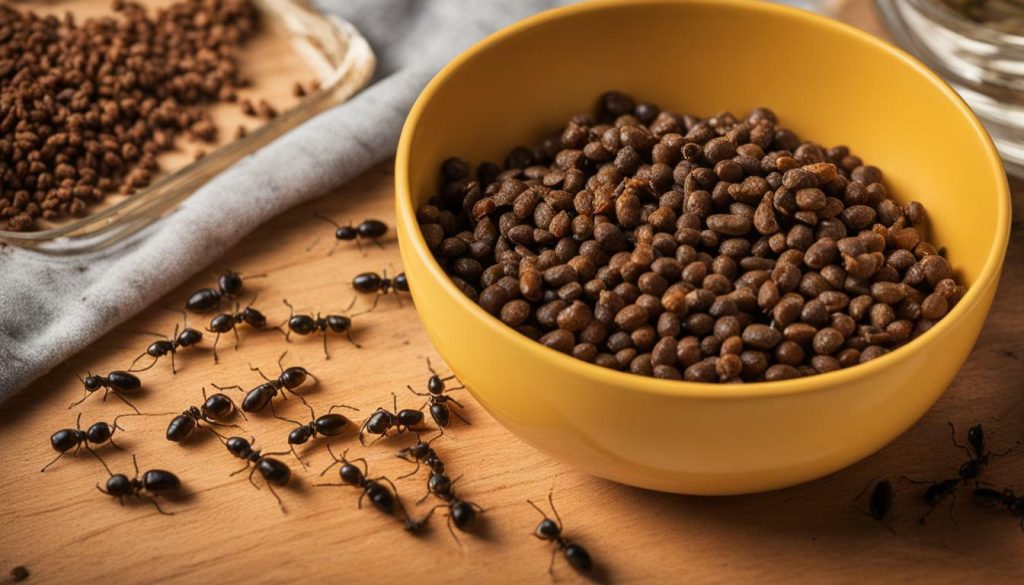
“Ants dislike the smell of certain herbs and spices.”
By following these simple steps, you can create a less attractive environment for ants and minimize the chances of them reaching your dog’s food. However, it’s important to note that ants are persistent creatures, so it’s crucial to stay vigilant and take immediate action if you notice any signs of ant activity.
“By following these simple steps, you can create a less attractive environment for ants.”
Table 1: Natural Deterrents for Ants
| Herbs and Spices | Effectiveness |
|---|---|
| Cinnamon | High |
| Peppermint | Medium |
| Bay Leaves | Low |
“Table 1: Natural Deterrents for Ants”
Remember, prevention is key when it comes to keeping ants away from your dog’s food. By implementing these measures, you can help protect your furry friend from any potential health risks associated with ant consumption. Stay proactive and create a safe eating environment for your beloved pet!
Dealing with Ants in Dog Food
If ants have infiltrated your dog’s food, it is crucial not to use insecticides near the food and take appropriate measures to eliminate the ant problem. Instead, opt for non-toxic methods to ensure the safety of your pet’s food. Here are some steps you can take:
- Remove the infested food: Start by removing the infested food from your dog’s bowl and dispose of it properly. This will prevent your pet from consuming ants or any contaminated food.
- Thoroughly clean the food bowl: Clean your dog’s food bowl with warm, soapy water to remove any ant trails or leftover crumbs. Use a brush to scrub away any residue that may attract ants again.
- Seal gaps and entry points: Inspect your home for any cracks or gaps in doors, windows, or walls. Seal these openings to prevent ants from entering your house and reaching your pet’s food.
- Store food properly: Ensure that your dog’s food is stored in airtight containers to keep ants at bay. Ants rely on scent trails to find food sources, so sealing the food will make it less attractive to them.
- Use natural ant deterrents: There are several natural remedies that can repel ants. For example, sprinkling cinnamon, peppermint, or vinegar around your dog’s food bowl can help deter these pests. Ants dislike the strong smell of these substances and will be less likely to approach the area.
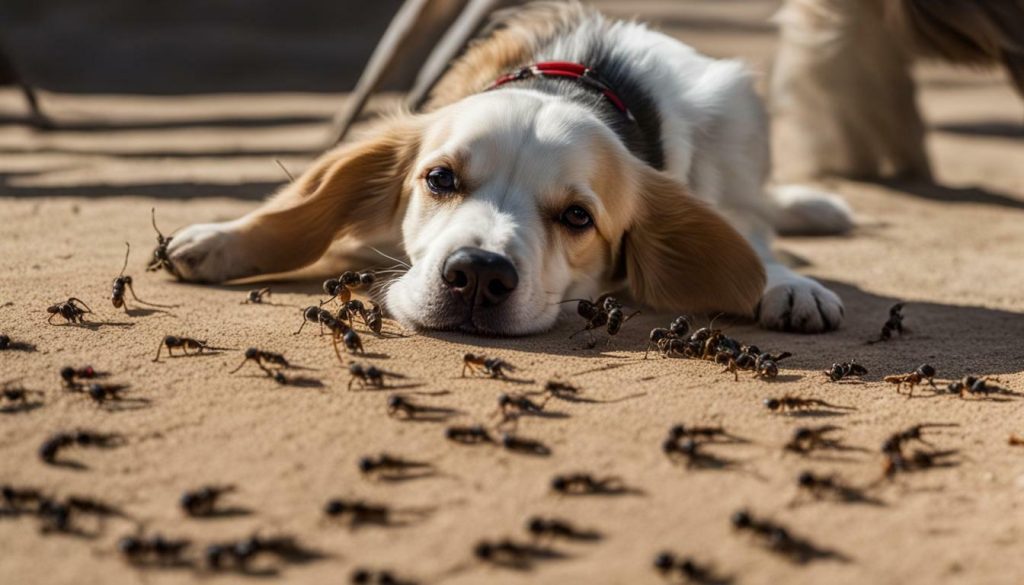
By following these steps, you can effectively deal with ants in your dog’s food without compromising their health. It is essential to prioritize your pet’s well-being by avoiding the use of harmful insecticides near their food.
Remember, prevention is key in keeping ants away from your dog’s food. Regular cleaning, proper storage, and the use of natural deterrents can help create an environment that is less attractive to these pesky creatures. If the ant infestation persists or becomes unmanageable, it is advisable to seek assistance from professional pest control services.
General Ant Prevention Tips for Dogs
Beyond food-related precautions, there are several general steps you can take to minimize the presence of ants in your home and yard. By implementing these simple strategies, you can create a safer and more comfortable environment for your furry friend.
- Keep your surroundings clean: Regularly clean up any food spills or crumbs, as these can attract ants. Wipe down countertops, sweep the floors, and vacuum regularly to eliminate potential food sources.
- Seal entry points: Ants can enter your home through even the tiniest cracks and crevices. Seal gaps in doorways, windows, and foundation walls to prevent ants from finding their way inside. Use silicone caulk or weatherstripping to seal off these entry points.
- Store food properly: Ants are attracted to food, so it’s important to store your dog’s food in airtight containers. Avoid leaving food bowls out for extended periods and clean them regularly to remove any lingering odor that may attract ants.
- Remove outdoor attractants: Ants can be abundant in your yard, so make sure to remove any potential attractants. Keep outdoor areas free of trash, pet waste, and fallen fruits. Trim back vegetation that may provide shelter or food sources for ants.
“Prevention is key when it comes to dealing with ants. By implementing these simple strategies, you can create a safe and ant-free environment for your beloved dog.”
Remember, ants are resourceful creatures, and even with the best prevention methods, they may still find their way into your home or yard. If you notice an ant infestation that you can’t control, it’s essential to seek professional pest control services to ensure the health and safety of your dog.

| Ant Species | Potential Harm |
|---|---|
| Fire ants | Can bite and sting, causing pain, swelling, and allergic reactions in dogs |
| Carpenter ants | Can bite and have powerful jaws that can cause pain and swelling |
| Harvester ants | Can bite and inject formic acid, causing pain, irritation, and potential allergic reactions in dogs |
Conclusion
While ants can be consumed by dogs, it is important to be aware of the potential risks and take necessary precautions to ensure your pet’s health and safety are prioritized.
Dogs may find ants intriguing and may be tempted to snack on them. However, it is crucial to monitor their ant consumption and be mindful of the type of ants they encounter. Some ant species can release harmful substances or have an acidic taste that can cause discomfort for dogs.
If your dog ingests a small number of ants, observe them closely for any signs of discomfort or unusual behavior. In most cases, a few ants will not pose a significant threat. However, if your dog consumes a larger quantity or encounters harmful ant species, immediate veterinary assistance is recommended.
Training your dog to ignore or walk away from ants can be beneficial in preventing potential problems. Using the “Leave It” command during walks or outdoor activities can help teach your dog to avoid ants and other potential hazards.
Additionally, keeping ants away from your dog’s food is essential. Regular cleaning of food bowls, proper storage of food, and the use of natural deterrents can help deter ants from your pet’s food supply. If ants have already invaded your dog’s food, it is important to avoid using insecticides near the food. Instead, opt for non-toxic alternatives like diatomaceous earth around the perimeter of your home.
By following these precautions and being vigilant about your dog’s interaction with ants, you can help ensure their health and safety. Remember, while ants may seem like harmless snacks, it is vital to prioritize your dog’s well-being and take necessary steps to prevent any potential risks.
FAQ
Can dogs eat ants?
Yes, dogs can eat ants. However, it is generally not recommended due to potential discomfort and the presence of harmful substances in certain species of ants.
What are the potential risks of dogs eating ants?
Dogs may experience stomach upset or allergic reactions when consuming a larger quantity of ants or ants that are known to be harmful.
How do different species of ants affect a dog’s safety?
Different species of ants can have varying levels of acidity and may bite or sting, causing problems for dogs.
What potential discomfort and allergic reactions can dogs experience after eating ants?
Dogs may experience stomach discomfort or allergic reactions such as itchiness, swelling, or difficulty breathing after consuming ants.
How can I monitor my dog’s ant consumption?
It is important to monitor your dog for any signs of discomfort or unusual behavior after they have eaten ants.
How can I train my dog to avoid ants?
You can teach your dog to ignore or walk away from ants using the “Leave It” command as part of their training.
How can I keep ants out of my dog’s food?
Strategies to keep ants away from your dog’s food include regular cleaning, proper storage, and using natural deterrents.
What should I do if ants are already in my dog’s food?
If ants have already found their way into your dog’s food, it is important to not use insecticides near the food. Instead, use non-toxic insecticides around the perimeter of your home and clean the food bowl regularly.
What are some general ant prevention tips for dogs?
To prevent ants from becoming a nuisance and potential health risk for your dog, seal gaps in doorways and windows, store food properly and seek professional pest control if needed.

